Stout
Stout is a dark, top-fermented beer with a number of variations, including dry stout, oatmeal stout, milk stout, and imperial stout.

The first known use of the word stout for beer, in a document dated 1677 found in the Egerton Manuscripts, referred to its strength.[1] The name porter was first used in 1721 to describe a dark brown beer. Because of the huge popularity of porters, brewers made them in a variety of strengths. The stronger beers, typically 7% or 8% alcohol by volume (ABV), were called "stout porters", so the history and development of stout and porter are intertwined, and the term stout has become firmly associated with dark beer, rather than just strong beer.[2][3][4][5]
History
Porter originated in London, England in the early 1720s.[6] The style quickly became popular in the city, especially with porters (hence its name): it had a strong flavour, took longer to spoil than other beers, was significantly cheaper than other beers, and was not easily affected by heat.[7][8] Within a few decades, porter breweries in London had grown "beyond any previously known scale".[8] Large volumes were exported to Ireland and by 1776 it was being brewed by Arthur Guinness at his St. James's Gate Brewery.[9] In the 19th century, the beer gained its customary black colour through the use of black patent malt, and became stronger in flavour.[3]
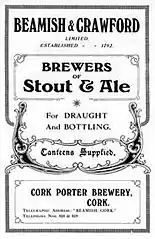
Originally, the adjective stout meant "proud" or "brave", but later, after the 14th century, it took on the connotation of "strong". The first known use of the word stout for beer was in a document dated 1677 found in the Egerton Manuscript,[1] the sense being that a stout beer was a strong beer. The expression stout porter was applied during the 18th century to strong versions of porter. Stout still meant only "strong" and it could be related to any kind of beer, as long as it was strong: in the UK it was possible to find "stout pale ale", for example. Later, stout was eventually to be associated only with porter, becoming a synonym of dark beer.
Because of the huge popularity of porters, brewers made them in a variety of strengths. The beers with higher gravities were called "Stout Porters". There is still division and debate on whether stouts should be a separate style from porter. Usually the only deciding factor is strength.[10]
"Nourishing" and sweet "milk" stouts became popular in Great Britain in the years following the First World War, though their popularity declined towards the end of the 20th century, apart from pockets of local interest such as in Glasgow with Sweetheart Stout.
Beer writer Michael Jackson wrote about stouts and porters in the 1970s, but in the mid 1980s a survey by What’s Brewing found just 29 brewers in the UK and Channel Islands still making stout, most of them milk stouts.[11] In the 21st century, stout is making a comeback with a new generation of drinkers, thanks to new products from burgeoning craft and regional brewers.[12]
Milk stout
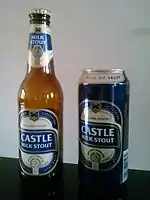
Milk stout (also called sweet stout or cream stout) is a stout containing lactose, a sugar derived from milk. Because lactose cannot be fermented by beer yeast, it adds sweetness and body to the finished beer. Milk stout, which was claimed to be nutritious, was given to nursing mothers,[13][14] and to help increase their milk production.[15] The classic surviving example of milk stout is Mackeson's,[16] for which the original brewers advertised that "each pint contains the energising carbohydrates of 10 ounces [284 ml] of pure dairy milk". The style was rare until being revived by a number of craft breweries in the twenty-first century.
There were prosecutions in Newcastle upon Tyne in 1944 under the Food and Drugs Act 1938 regarding misleading labelling of milk stout.[17]
Dry or Irish stout
With milk or sweet stout becoming the dominant stout in the UK in the early 20th century, it was mainly in Ireland that the non-sweet or standard stout was being made. As standard stout has a drier taste than the English and American sweet stouts, they came to be called dry stout or Irish stout to differentiate them from stouts with added lactose or oatmeal.[18][19][20] This is the style that represents a typical stout to most people.[21] The best selling stouts worldwide are Irish stouts made by Guinness (now owned by Diageo) at St. James's Gate Brewery (also known as the Guinness Brewery) in Dublin. Guinness makes a number of different varieties of its Irish stouts.[22][23] Other examples of Irish dry stout include Murphy's and Beamish, now both owned by Heineken.[21] Native Irish stouts are brewed by independent Irish craft breweries, most of whom include a stout in their core ranges. Draught Irish stout is normally served with a nitrogen propellant in addition to the carbon dioxide most beers use, to create a creamy texture with a long-lasting head.[24] Some canned and bottled stouts include a special device called a "widget" to nitrogenate the beer in the container to replicate the experience of the keg varieties.[25]
Gallery of Irish stouts
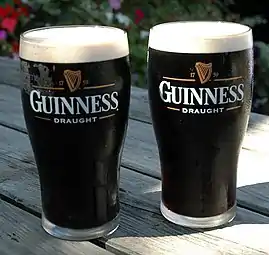 Draught Guinness
Draught Guinness.JPG.webp) Guinness Foreign Extra
Guinness Foreign Extra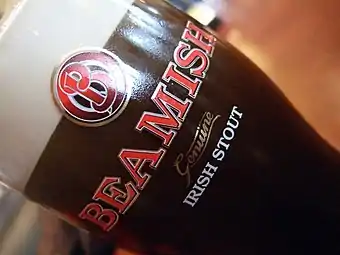 Beamish Genuine Irish Stout
Beamish Genuine Irish Stout_(cropped).jpg.webp) Murphy's Irish Stout
Murphy's Irish Stout
Porter
There were no differences between stout and porter historically,[26] though there had been a tendency for breweries to differentiate the strengths of their beers with the words "extra", "double" and "stout". The term stout was initially used to indicate a stronger porter than other porters from a brewery.[27]
Oatmeal stout
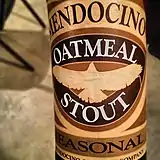
Oatmeal stout is a stout with a proportion of oats, normally a maximum of 30%, added during the brewing process. Even though a larger proportion of oats in beer can lead to a bitter or astringent taste,[28] during the medieval period in Europe, oats were a common ingredient in ale,[29] and proportions up to 35% were standard. Despite some areas of Europe, such as Norway, still clinging to the use of oats in brewing until the early part of the 20th century, the practice had largely died out by the 16th century, so much so that in 1513 Tudor sailors refused to drink oat beer offered to them because of the bitter flavour.[30][31]
There was a revival of interest in using oats during the end of the 19th century, when (supposedly) restorative, nourishing and invalid beers, such as the later milk stout, were popular, because of the association of porridge with health.[32] Maclay of Alloa produced an Original Oatmalt Stout in 1895 that used 70% "oatmalt", and a 63/- Oatmeal Stout in 1909, which used 30% "flaked (porridge) oats".[33]
In the 20th century, many oatmeal stouts contained only a minimal amount of oats. For example, in 1936 Barclay Perkins Oatmeal Stout used only 0.5% oats.[34] As the oatmeal stout was parti-gyled with their porter and standard stout, these two also contained the same proportion of oats. (Parti-gyle brewing involves blending the worts drawn from multiple mashes or sparges after the boil to produces beers of different gravities.) The name seems to have been a marketing device more than anything else. In the 1920s and 1930s Whitbread's London Stout and Oatmeal Stout were identical, just packaged differently. The amount of oats Whitbread used was minimal, again around 0.5%.[35] With such a small quantity of oats used, it could only have had little impact on the flavour or texture of these beers.
Many breweries were still brewing oatmeal stouts in the 1950s, for example Brickwoods in Portsmouth, Matthew Brown in Blackburn and Ushers in Trowbridge.[36] When Michael Jackson mentioned the defunct Eldrige Pope "Oat Malt Stout" in his 1977 book The World Guide to Beer, oatmeal stout was no longer being made anywhere, but Charles Finkel, founder of Merchant du Vin, was curious enough to commission Samuel Smith to produce a version.[37] Samuel Smith's Oatmeal Stout then became the template for other breweries' versions.
Oatmeal stouts do not usually taste specifically of oats. The smoothness of oatmeal stouts comes from the high content of proteins, lipids (includes fats and waxes), and gums imparted by the use of oats. The gums increase the viscosity and body adding to the sense of smoothness.[38]
Oyster stout
.JPG.webp)
Oysters have had a long association with stout. When stouts were emerging in the 18th century, oysters were a commonplace food often served in public houses and taverns. By the 20th century, oyster beds were in decline, and stout had given way to pale ale. Ernest Barnes[39] came up with the idea of combining oysters with stout using an oyster concentrate made by Thyrodone Development Ltd. in Bluff, New Zealand, where he was factory manager.[40] It was first sold by the Dunedin Brewery Company in New Zealand in 1938, with the Hammerton Brewery in London, UK, beginning production using the same formula the following year.[41] Hammerton Brewery was re-established in 2014 and is once again brewing an oyster stout.
Modern oyster stouts may be made with a handful of oysters in the barrel, hence the warning by one establishment, the Porterhouse Brewery in Dublin, that their award-winning Oyster Stout was not suitable for vegetarians.[42] Others, such as Marston's Oyster Stout, use the name with the implication that the beer would be suitable for drinking with oysters.
Chocolate stout
Chocolate stout is a name brewers sometimes give to certain stouts having a noticeable dark chocolate flavour through the use of darker, more aromatic malt; particularly chocolate malt—a malt that has been roasted or kilned until it acquires a chocolate colour. Sometimes, as with Muskoka Brewery's Double Chocolate Cranberry Stout, Young's Double Chocolate Stout, and Rogue Brewery's Chocolate Stout, the beers are also brewed with a small amount of chocolate, chocolate flavouring, or cacao nibs.[43][44]
Imperial stout

Imperial stout, also known as "Russian Imperial stout", is a strong dark beer in the style that was brewed in the 18th century by Thrale's Anchor Brewery in London for export to the court of Catherine II of Russia.[45] In 1781 the brewery changed hands and the beer became known as "Barclay Perkins Imperial Brown Stout".[46] It was shipped to Russia by Albert von Le Coq who was awarded a Russian royal warrant which entitled him to use the name "Imperial".[47] Historical analyses from the time period of 1849 to 1986 show that the beer had an original gravity between 1.100 and 1.107 and an alcohol content of around 10% ABV. This remained virtually unchanged over the whole time period.[48] A recipe from 1856 also indicates that it was hopped at a rate of 10 pounds of hops to the barrel (28 g/L). When Barclay's brewery was taken over by Courage in 1955, the beer was renamed "Courage Imperial Russian Stout" and it was brewed sporadically until 1993.[49] The bottle cap still said "Barclay's".[50]
In Canada, Imperial Stout was produced in Prince Albert first by Fritz Sick, and then by Molson following a 1958 takeover.[51] Denmark's Wiibroe Brewery launched its 8.2 percent Imperial Stout in 1930.[52] The first brewery to brew an Imperial Stout in the United States was Bert Grant's Yakima Brewing.[53]
Imperial stouts have a high alcohol content, usually over 9% abv, and are among the darkest available beer styles. Samuel Smith's brewed a version for export to the United States in the early 1980s, and today Imperial stout is among the most popular beer styles with U.S. craft brewers.[49] American interpretations of the style often include ingredients such as vanilla beans, chili powder, maple syrup, coffee, and marshmallows. Many are aged in bourbon barrels to add additional layers of flavour.[54] The word "Imperial" is now commonly added to other beer styles to denote a stronger version, hence Imperial IPAs, Imperial pilsners etc.[55]
Baltic porter is a version of Imperial stout which originated in the Baltic region in the 19th century. Imperial stouts imported from Britain were recreated locally using local ingredients and brewing traditions.[56]
Gallery of imperial stouts
 Courage Imperial Russian Stout
Courage Imperial Russian Stout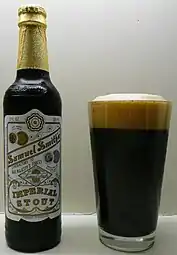 Samuel Smith's
Samuel Smith's
Imperial Stout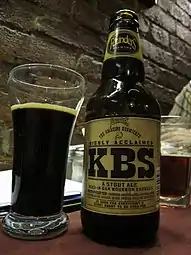 Founders Kentucky Breakfast Stout
Founders Kentucky Breakfast Stout Great Divide
Great Divide
Oak Aged Yeti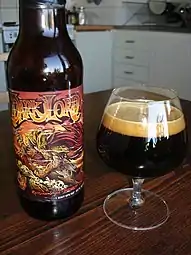 Three Floyds
Three Floyds
Dark Lord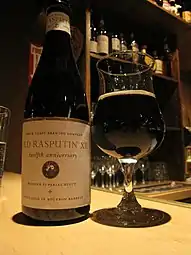 North Coast
North Coast
Old Rasputin XII.jpg.webp) Carlsberg
Carlsberg
Wiibroe Imperial Stout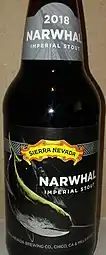 Sierra Nevada
Sierra Nevada
Narwhal
Pastry stout
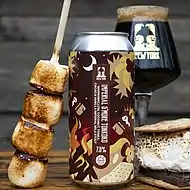
A pastry stout is a stout beer which is brewed to be intentionally sweet with the end goal that the beer mimics the flavor and sometimes the appearance of a dessert.[57] Many breweries who produce pastry stouts will experiment with flavors such as (but not limited to) chocolate, marshmallow, maple syrup, vanilla, and various fruit. The finished product will have the flavor and aroma of popular sweets such as blueberry pancakes, s’mores, donuts, brownies, cake, ice cream and fruit crumble just to name a few.
References
- Lewis, Michael (2017). Stout (Classic Beer Style). Brewers Publications. ISBN 9781938469435.
- The New Oxford Dictionary of English. Oxford University Press 1998 ISBN 0-19-861263-X
- Porter and Stout – CAMRA, Web.archive.org
- "Michael Jackson's Beer Hunter – Porter casts a long shadow on ale history". Beerhunter.com.
- Johnston, Zach (28 March 2018). "Picking Apart The Minute Differences Between Porter And Stout". Uproxx. Retrieved 21 January 2020.
- Bamforth, Charles (2009). Beer: Tap into the Art and Science of Brewing. Oxford University Press. p. 65. ISBN 978-0195305425
- Unger, Richard W. (2004). Beer in the Middle Ages and the Renaissance. University of Pennsylvania Press. p. 244. ISBN 978-0812237955
- Bender, David A. (2009). A Dictionary of Food and Nutrition. Oxford University Press. ISBN 978-0199234875
- Oliver, Garrett (2011). The Oxford Companion to Beer. Oxford University Press. p. 492. ISBN 978-0195367133
- Cornell, Martyn (19 March 2009). "So what IS the difference between porter and stout?". Zythophile.wordpress.com. Retrieved 20 July 2018.
- "Endangered beers | Zythophile". Zythophile.wordpress.com. 22 May 2012. Retrieved 15 August 2012.
- "The Guardian. British drinkers toast stout revival". TheGuardian.com.
- "The Stout Without Gout – December 2008 Document of the Month – Dorset For You". Dorsetforyou.com. Retrieved 13 March 2009.
- "Guinness to brew anniversary stout to mark 250th birthday – Food & Drink, Life & Style". Belfasttelegraph. Retrieved 13 March 2009.
- BurnSilver, Glenn. "Milk Stout: It Does a Body Good". Byo.com. Retrieved 11 May 2017.
- Rabin, Dan; Forget, Carl (1 October 1998). The Dictionary of Beer and Brewing. ISBN 978-1-57958-078-0.
- "Milk stout prosecutions, 1944". I might have a glass of beer. 22 October 2011. Retrieved 21 November 2016.
- Oxford Companion to Beer. Oxford University Press. 2011. p. 494.
- Ronald Pattinson. Porter!. Lulu. p. 343.
- Keith Klemp (1 July 2012). "Milk Stout". All About Beer Magazine. Vol. 33, no. 3.
- Bryce Eddings. "A Layman's Guide to Stout – Introduction to Stout Styles". About.com.
- Bill Yenne (5 October 2007). Guinness: The 250 Year Quest for the Perfect Pint. John Wiley & Sons. p. 186.
- K. Florian Klemp (17 March 2015). "The Evolution of Dry Stout". Allaboutbeer.com/.
- "Protz On Beer. Good beer – and choice – return to Ireland.".
- Holl, John (24 January 2013). "Good Beer Gas: Nitro Beers Explained". craftbeer.com. Retrieved 1 April 2021.
- Cornell, Martyn (19 March 2009). "So what IS the difference between porter and stout?". Zythophile.co.uk.
- "Porter and Stout – CAMRA". Camra.org.uk.
- Page 50, Stout, Michael J. Lewis, published 1995 by Brewers Publications, ISBN 0-937381-44-6
- Page 49, Beer: The Story of the Pint, Martyn Cornell, published 2003 by Hodder Headline, ISBN 0-7553-1164-7
- Page 78, Beer: The Story of the Pint, Martyn Cornell, published 2003 by Hodder Headline, ISBN 0-7553-1164-7
- "Databases". Libguides.lib.hku.hk.
- Page 158, Beer: The Story of the Pint, Martyn Cornell, published 2003 by Hodder Headline, ISBN 0-7553-1164-7
- Pages 59 & 60, Old British Beers, Dr. John Harrison, published 2003 by Durden Park Beer Circle, ISBN 0-9517752-1-9
- Barclay Perkins brewing records in the London Metropolitan Archives
- Whitbread brewing records in the London Metropolitan Archives
- Whitbread Gravity Book, Whitbread Archive in the London Metropolitan Archives
- "Michael Jackson's Beer Hunter – Kisses, oats and stouts". Beerhunter.com.
- Galante, Stephan (October 1997). "Brew Your Own: The How-To Homebrew Beer Magazine – Beer Styles – Oatmeal Stout". Byo.com. Retrieved 28 November 2011.
- "Ernest Barnes". Barnes Wild Bluff Oysters. Retrieved 15 April 2018.
- "Oyster Stout, Otago Daily Times, Issue 23805, 11 May 1939". Retrieved 15 April 2018 – via Papers Past.
- "Oyster Stout, Otago Daily Times, Issue 23806, 12 May 1939". Retrieved 15 April 2018 – via Papers Past.
- "Porterhouse". Porterhousebrewco.com. Retrieved 15 August 2012.
- "Young's Double Chocolate Stout – Charles Wells". Chalreswells.co.uk.
- "Rogue Ales & Spirits". Rogue.com.
- John Pudney (1971). A draught of contentment: the story of the Courage Group.
- Blocker, Jack S.; Fahey, David M.; Tyrrell, Ian R. (2003). Alcohol and Temperance in Modern History: An International Encyclopedia. ABC-CLIO. p. 177. ISBN 978-1-57607-833-4.
- "Morning Advertiser. Back to black: Baltic porter is heading for pole position.".
- Pattinson, Ron (9 January 2022). "Imperial Russian Stout 1849 - 1986". Retrieved 21 January 2022.
- "Beer and Brewing. The Oxford Companion to Beer definition of imperial stout.".
- "Barclay's Russian Imperial Stout, 1970". 31 August 2017.
- "University of Saskatchewan MG 401 - R.L. ("Dick") Sweet – Breweriana Collection. (p26)" (PDF).
- Helsingør Leksikon. Wiibroes Bryggeri. (in Danish)
- "Michael Jackson's Beer Hunter. How Bert Grant Saved The World.".
- "The Takeout. Venture to the dark side of the brew with imperial stouts.".
- "Beer and Brewing. The Oxford Companion to Beer definition of "imperial".".
- Klemp, K. Florian. "Big Baltic Porter". All About Beer Magazine. 29 (1).
- Reddy, Abhinav (25 June 2021). "What Are Pastry Stouts? » Brewer World-Everything about beer is here". Brewer World-Everything about beer is here. Retrieved 7 December 2021.
External links
 Media related to Stout at Wikimedia Commons
Media related to Stout at Wikimedia Commons